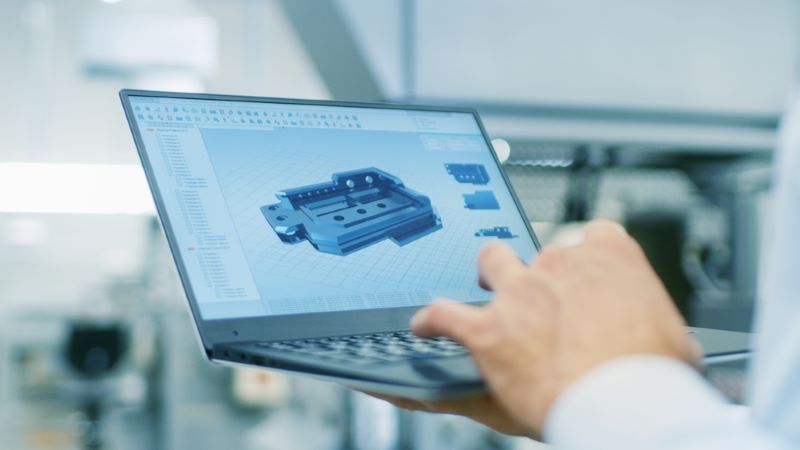Click here to get this post in PDF
In the dynamic sphere of product design, staying ahead on the innovation curve is a non-negotiable criterion for success. To convert ambitious ideas into tangible prototypes promptly and cost-effectively is no easy feat. However, this is changing with the integration of computer-aided design (CAD) in the rapid prototyping process. This smart technological pairing is now acting as a powerful catalyst, accelerating the innovation lifecycle and reshaping the design-to-manufacturing path.
Embracing CAD: Propelling Product Design into the Future
Innovation in product design is deeply rooted in efficient problem-solving. Let’s delve into how adopting CAD can fast-track prototype development and open new avenues of innovation. The integration of CAD in the prototyping process not only expedites the conceptualization to reality journey but also facilitates an immersive design experience. It creates a virtual simulation space, where designers can experiment, tweak, and observe the impact of changes in real-time. This eliminates the logistical constraints of traditional prototype development and enables designers to innovate with freedom. Additionally, the ability of CAD to develop precise and detailed models reduces errors, boosting productivity and efficiency. Hence, embracing CAD in product design is indeed a step into the future of rapid and innovative prototyping.
Reduced Design-to-Prototype Time
Time saved is innovation earned in the realm of product design. CAD software can drastically shorten the time between ideation and prototype creation. This allows for quicker testing, alterations and validation, speeding up the overall development process.
CAD services are becoming an increasingly popular choice for businesses looking to navigate these benefits efficiently. These services offer seamless integration of CAD technology into your existing infrastructure, allowing you to harness its potential without significant capital investment or technical expertise.
Enhanced Accuracy, Less Error
Accuracy is critical in design and prototyping. CAD software can facilitate precise designs, reducing the likelihood of errors. This precision, in turn, leads to less wasted time and material, a boon when prototyping.
Visualization and Collaboration
The ability to visualize a design in a 3D model helps in understanding and communication between different teams. This, in conjunction with real-time feedback and collaborative features of many CAD platforms, fosters greater innovation and productivity.
Iterative Process, Improved Product
The greatest asset of CAD in the prototyping process is its provision for an iterative development process. The ability to revise and remodel with ease enables designers to experiment without constraints, fostering an environment that stimulates innovation. The iterative design capability of CAD virtually removes the fear of failure from the design process. With CAD, designers can make modifications on the digital model, test functionalities, assess performance under different scenarios, and rectify flaws, all before a physical prototype is built. This iterative process improves the quality of the end product, as it ensures thorough testing, feedback, and refinement occur at each step of the design process. Therefore, the use of CAD in prototyping serves to enhance the product’s durability, functionality, and overall consumer appeal, leading to greater market success.
Is Outsourcing CAD a Feasible Option?
In an era where both speed and efficiency are paramount, outsourcing aspects of the design process like CAD drafting has become a considerable trend.
Outsource CAD drafting services can provide a cost-effective and efficient solution for businesses. With access to expert talent and cutting-edge tools, these services can handle a voluminous workload without adding to in-house resources or overhead costs. Many providers tend to showcase their capabilities through a professional website, offering portfolios, client testimonials, and case studies to help businesses make informed decisions.
In addition, outsourcing allows companies to scale operations quickly, whether for short-term projects or ongoing support. For instance, architectural firms can delegate detailed blueprints to external teams, while manufacturers leverage outsourced CAD services to refine product prototypes with greater precision.
Conclusion
CAD and rapid prototyping have emerged as essential tools for innovation in product design. Their potent combination breathes life into ideas quickly and accurately, providing an edge in a fiercely competitive market. As technology advances, their integration will only become more seamless, perpetually pushing the boundaries of what’s possible in product design. In essence, the pairing of CAD and rapid prototyping has transformed the design landscape, enabling rapid turnovers, increased precision, and fostering a creative exploration platform. This revolution significantly improves cost-efficiency and reduces the time to market, factors that can make or break a product’s success in today’s fast-paced world. Furthermore, the flexibility and adaptability of CAD make it future-ready, capable of integrating with evolving technological trends. Hence, the adoption of these tools not only boosts current product design capabilities but also prepares businesses for future innovations and advancements in the ever-evolving realm of design technology.
You may also like: How To Become a Professional Engineer
Image source: Depositphotos.com

